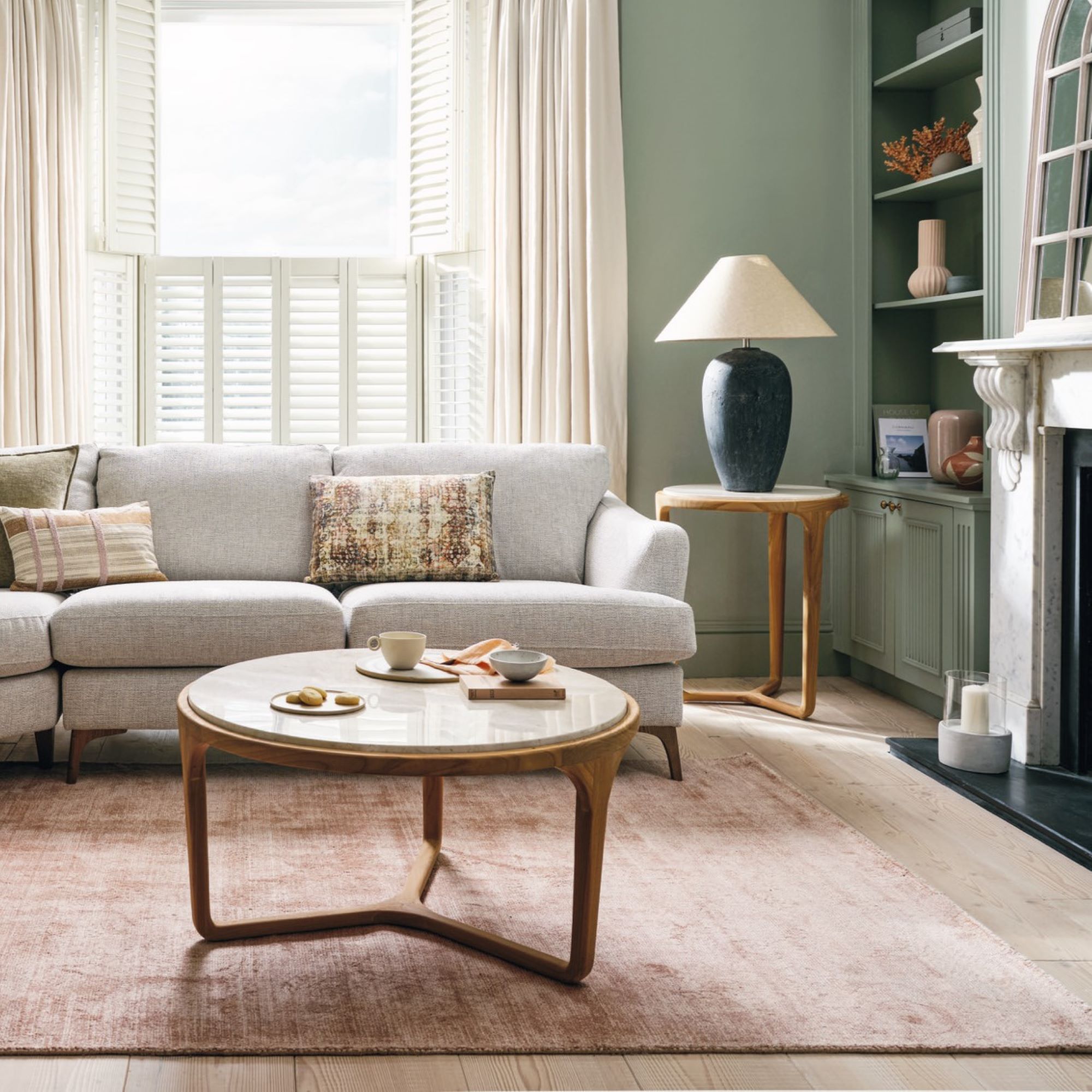Should a small living room have a rug? Design experts unanimously agree on this approach in a tiny space
Wondering if your small living room needs a rug? There might be a surprising lot to gain


Smaller living rooms shouldn't have to compromise on chic decor ideas. It's all about being savvy and smart with what you bring into the room, and this includes how you dress the floor. Asking the question 'should a small living room have a rug', is a good place to start when styling up a smaller space.
There are plenty of small living room ideas that help to maximise opportunity in compact living spaces. But knowing whether or not to include a rug can be tricky, as we might be conscious of bringing anything in that doesn't feel necessary. However, there are a surprising number of reasons why living room rug ideas are a good addition to smaller spaces.
'Smaller living rooms have a danger of feeling too cluttered, so you don’t want to overwhelm the space with pieces for no reason,' says Sarah Ross, Brand Director, Addison Ross. 'But when it comes to any living room, you’ll want to have some texture to ground the space.'

Should a small living room have a rug?
We wanted to get an expert-approved answer to the question - should a small living room have a rug - and get some accurate styling tips for smaller spaces. Here's everything you need to know from tips on where to put a rug in relation to the best sofas, to advice on what type of rug is best for smaller spaces.

With smaller living rooms, you should carefully consider what you bring into the space. Each piece should add something to the overall look and feel of the room, without making it feel crowded or cluttered.
There is no reason why a small living room shouldn't have a rug. In fact, the experts recommend adding a rug into smaller living spaces as they can provide additional texture in the room, without taking up too much space.
'Rugs can be a great addition to even the smallest of living rooms, making the space more functional whilst adding style, colour and pattern depending on the design you choose,' says Emma Deterding, Founder and Creative Director, Kelling Designs. 'A well-chosen rug can help to tie various elements like furniture and decor together, helping to create a cohesive look whilst adding warmth and texture underfoot.'
'A well-chosen rug will anchor the space, define different areas, and make the room feel more cohesive,' agrees Claire Garner, Director, Claire Garner Interiors. 'It adds a layer of warmth and texture and can create the illusion of a larger area by drawing the eye across the floor, adding depth.'
How to position rugs in smaller living rooms

Keep in mind the size of the rug, and where you're placing it. 'Larger rugs will give the effect of a more spacious and cohesive area, but rugs that are too small can make a room feel disjointed and cramped if they’re placed in the wrong area,' says Suzi Samaddar, Room Styling Expert, Furn.
'Usually it’s recommended for a rug to cover 70% of your floor space, however in smaller living rooms it can often work better to have the rug under your coffee table and nothing else. As coffee tables are often placed centrally in the room, adding the rug underneath will bring focus to this space.'
In relation to living room sofa ideas, the rule of thumb is that the front legs of the sofa should sit on top of the rug, as this helps to anchor the seating area and define the space. 'If possible, have all furniture legs on the rug to create an even more cohesive and spacious feel,' Claire Garner adds.
What type of rug is best for small living rooms?
So the answer to the question - should a small living room have a rug - is a resounding yes. Just make sure to take on board advice from the experts and position the rug in the centre of the room, with visual floor space around all the edges. This will help the floor feel more expansive, and the room feel bigger.

It's also important to consider the different styles of rugs, as some will work better than others in small living areas. Most importantly, it needs to blend seamlessly with the rest of your living room decor; if it stands out too much, it will quickly make the space feel overcrowded and cluttered.
'Instead of investing in an asymmetrical piece, make sure your rug mirrors the shape of your room,' Sarah from furn says. 'So if you have a small rectangle living room, you’ll want to use a rectangle rug for your space, with the same rule applying if you are dressing a square room.'
Try and match your rug to your living room colour scheme as well, so that it visually fits with the space. 'You can use neutral tones like beige, grey, or white, which can make a room feel larger and more open,' says Polya Petrova, Fantastic Services. 'Whereas minimalist or geometric patterns can add interest without overwhelming the space, and subtle stripes or small-scale designs are great choices.'

Get the look

This neutral scalloped rug is ideal for adding on-trend flair to a small space without overwhelming it.
FAQs
Does a rug make a room look bigger or smaller?
Whether or not a rug makes a room look bigger or smaller really depends on the type of rug, and how it is placed. If you're dressing a smaller room, opt for rugs that are more simple in design.
'Rugs can make a room look bigger or smaller depending on their style and colour,' Holly Ambrose, Interior Designer, Roomes explains. 'A heavily patterned rug or one with dark colours may make the room feel cosier but slightly smaller. On the other hand, a neutral rug with less pattern, perhaps more abstract, can help to give the illusion of a larger room.'
'Multiple rugs layered haphazardly will ultimately add to the clutter of a room and squeeze out any remaining space the room has left, but when you fit one large area rug that takes up most of the room's centre space, it has the opposite effect,' says Scott Jones, Fab Home Interiors. 'Colour choice is also important, opting for cool tones or light shades will trick the eye into thinking you're in a much more open space.'
What is the rule on rugs in a living room?
'As a general rule of thumb, living room rugs should extend at least 6-8 inches beyond the main seating pieces on all sides,' says Ryan Nelson, Rental Real Estate. 'This allows the front legs of larger furniture like sofas and chairs to sit comfortably on the rug.'
The experts agree that ideally, the front legs of your sofa should sit on top of your rug. If you're living room is on the smaller side and this isn't possible, just try to ensure there is a decent amount of exposed floor space around the rug. This will help the room feel more open and expansive.
'Making sure the rug is in the centre of the room, with about 12 inches of bare floor around the edges will give the space a nice feeling of dimension,' says Sarah from Addison Ross.
Now you know the answer to 'should a small living room have a rug' (yes!), will you be sprucing up your living area with a new addition to your floor?
Get the Ideal Home Newsletter
Sign up to our newsletter for style and decor inspiration, house makeovers, project advice and more.

Katie has been writing freelance since early 2022, specialising in all things homes and gardens, following achieving a Masters in Media and Journalism. She started out writing e-commerce content for several of Future’s interior titles, including Real Homes, Gardeningetc, Livingetc, and Homes and Gardens. Since then she’s been a regular contributor on Ideal Home’s digital team, covering news topics, how-to guides, and product reviews.
-
 The 8 things you didn't know you could pressure wash and how to clean them the right way, according to experts
The 8 things you didn't know you could pressure wash and how to clean them the right way, according to expertsPressure washers are great for patios, but what else can you wash with them?
By Sophie Warren-Smith
-
 Zen garden ideas on a budget – 5 simple ways to introduce the minimalist concept to your outdoor space
Zen garden ideas on a budget – 5 simple ways to introduce the minimalist concept to your outdoor spaceIt's an ultra-affordable garden design scheme
By Sophie King
-
 I'm a stylist with an eye for expensive-looking high street finds – these 6 garden furniture pieces at Dunelm are on my radar
I'm a stylist with an eye for expensive-looking high street finds – these 6 garden furniture pieces at Dunelm are on my radarThese pieces all look more than their price tag
By Laurie Davidson

